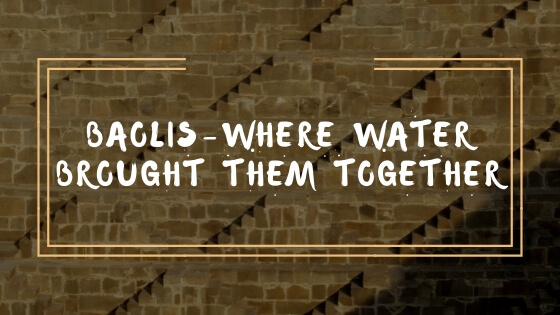
Long back I tweeted about how I deleted a draft on Baolis, as I found better works on the same topic & I wasn’t satisfied with mine. Few folks scolded me and asked to publish it. This post is for them & because of them.
I am still not happy with what I have scribbled below, but I had to write it for reasons mentioned in the epilogue. Do check the links I have shared in the end.
Baolis, or step-wells are known by different names in different cultures. Once a lifeline for those who stayed around them, today they are just another monument for the visiting tourists.

Agrasen-ki-baoli, near Connaught Place, Delhi
Lifeline of our Civilization
Baoli’s are my favourite when it comes to heritage buildings or monuments. No other monument, has ever talked to me like a Baoli. It told me about culture, people and about the necessity of water for human settlements – why else would they create these beautiful structures around those wells. Today, they are just pits and some are centuries old garbage bins!

Love At First Sight
My first visit to a Baoli was in Delhi, around four years back. A heritage walk through Mehrauli Archaeological Park introduced me to the first Baoli in my life: Rajon-ki-Baoli (above). Like a first love, it still remains my favourite Baoli. If you visit me in Delhi, I will take you there, like it or not.
Types of Baolis
A Baoli, or a step-well is built around a well. For those who haven’t seen a well, its a few feet wide manmade hole, dug deep into the earth (some 50+ feet or more deep), till enough water is found. Or you may say, a miniature but deep pond. There are many shapes and sizes of a Baoli. Some circular, some rectangular, some are L-shaped and some are even helical! – Baoli’s also tells us the tale of an advanced skill force from the bygone era.

pic above: walk into the well @ L-shaped Amritavarshini Vaav, Ahmedabad
Some Baolis are created on one side of a well. Adjacent to the well, they build a pond. Steps were constructed, leading into the pond, till few feet below the level of water (pic below: you can see my 6 ft tall friend standing on the steps for the height calculation; at Rajon-ki-Baoli). They also constructed beautiful structures around this pond for people to relax and do their chores.

In my limited understanding: as the water level decreases, they dig the pond deeper and made more steps to reach the pond. Every time a new level is created, older levels became changing rooms or places to sit and relax (see-below). Some Baolis even had mosques attached to it!

pic above: @Zenrainman walking into the well of Rajon-ki-baoli through the connection between the well and pond.
He also told me how govt. dumped garbage into these monuments few decades back to prevent spreading of diseases through contaminated water
pic below: Rajon-ki-baoli, Mehrauli Archaeological Park, New Delhi

Water is usually drawn from the well by a bucket and pulley system while people could also walk down the steps to the pond for other activities. (pic below: Baoli at Farrukh Nagar, near Delhi-NCR; notice the platform on left end which was used to mount the pulley to draw water)

pic below: Baoli at Paanchkuvan Darwaza, Ahmedabad;
notice the stones laid for the people to stand and draw water?
also the opening on the left from the steps

In case of circular Baolis, they have steps leading into a huge well instead of separate well and pond. A beautiful example of a circular Baoli is the one at Feroz Shah Kotla ( pic below). It still has water in it, even after its 700+ years of service.

There are also Octagonal shaped Baolis like the one in Farrukh Nagar just outside Gurgaon (Delhi-NCR), pic below.

This Baoli at Farrukh Nagar even has a tunnel (now sealed) to the near-by palace for the royal women to reach the Baoli! In fact, we had to use a tunnel to enter this Baoli, under a State Highway (pic below)!

Work of Art
In Ahmedabad, few months back, I chanced upon an L-shaped Baoli built behind one of Amdavad’s (old Ahmedabad) Paanchkuvan gate. I went to Ahmedabad in search of their famous step-wells with beautiful stone works at Adalaj, but the first one i encountered was a very simple L-shaped ‘Amritavarshini vaav’. From the construction, its clear that this step-well was for travellers and locals who passed through the gate and hence a very simple, and neat design, making the most out of the available space!

pic above & below: the beautifully carved, huge step-wells of Adalaj near Ahmedabad.
I am not an avid archaeology or heritage enthusiast like many of my friends, its just that some monuments talk to me.
As I walked down the steps of the first Baoli in my life (Rajon-ki-Baoli, Mehrauli),
the grandeur of its construction was the last thing in my mind.
Instead, I was travelling back in time, centuries back,
when this Baoli was filled with water.
I saw women drawing water from the well up above,
I saw them sitting together, engrossed in discussions
under the arches on either sides of the step-well.
I saw naked kids running up and down the steps,
while the priest offered his prayers with foot immersed in the water.
Then there are the washer men carrying the robes of nobles,
cows climbing down the steps to quench their thirst,
stray dogs sleeping by the shades…everyone i can think of in a village, was there.
Love of a Lifetime
That day, I hesitantly walked away from the Baoli to continue with the group. But ever since then, I visit Rajon-ki-Baoli once a month and drag few friends along with me every time I go. Obviously, very few appreciate it, rest of them just stare at me (I guess they are thinking of a psychiatrist for me).
But then I don’t care, for me it’s a realisation of how a civilization, which depended less on technology, lived a better life than us. It tells me how water and air is important to us, and they with their limited knowledge (centuries back) understood and adapted to this!
Baoli’s are a treasure of stories and information, while it reveals a lot about past, it also gives food for ones thoughts about our present & future.

Someday, i hope to rest by a baoli (pic above) and travel through time endlessly. Have you been to one? Share a picture if you have one.
disclaimer:
After a conversation with few foreign travellers in Udaipur, I realized that I should try to spread word about Baoli (even though I have a limited knowledge and a limited reach) as much as I can, so that these beautiful structures will be visited and may get preserved for our future generation. This post is my understanding about Baolis’ and I would like to believe that it gave you some insight on these beautiful structures.
Here are some useful links for better knowledge and understanding on Baolis:
- India’s forgotten step-wells by Victoria Lautman
(information about many neglected Baoli’s across India – must read) - City Monuments – Baolis, step wells of Delhi by Mayank Austen Soofi
- A beautiful photo-journal on Baoli’s by Simon de Trey
- The lost Baoli of Lodhi garden & other posts on Baolis by Vikramjit Rooprai
- Step-wells of Gujarat by Abhilash Shekhawat
And some books:
- Steps to Water: The Ancient Step-wells of India by Morna Livingston
- The Step-wells of Gujarat: in Art-Historical Perspective by Jutta Jain-Neubauer











WOW! I have never seen a vaoli before – never even heard of them, but they look amazing! Really wish I’d visited somewhere like this when I went to India now! Will just have to go back, I suppose 😉 x
Baolis are ancient gifts. They had an amazing technique, really how smart our ancestors were. I had visited the one in Jaisalmer and haven’t visited others since I have moved away from India. Would definitely love to visit the one in Delhi and I can already imagine crazy instagrammable pic there.
Baolis are truly wonderful pieces of architecture and wisdom of the days of past. My first encounter with Baoli was in Delhi at Agrasen ki Baoil and from there my fascination for Baolis increased. I am alwys intrigued with the steps around the wells. Thanks for this lovely post. 🙂
Wow, these are mind blowing structures, and they have meaning too! I love the photos here, as you can see the intricate detailing in the stone. I’ve not yet been to India, but I’ll add seeing some baoli to the list!
First and foremost always publish what you write even if others have already discussed about the topic because your perspective is different from others and your article is really good. I never know what Baili is till I read your very informative content. Keep on writing and informing.
Before reading this post I had never heard about the Baolis. I’m so glad you did write this post so that I could learn more about this beautiful spot of the world. Your photos are lovely and I’m so glad to have learned all about it.
I didn’t know anything about baolis before reading this. I too am now fascinated by them! Such a combination of history, architecture, and a glimpse of how real-life technology impacts real people’s lives.
The architecture of the Baoli at Adalaj is incredible. I have never been to one before. I’ll have to check one out if we make it Delhi next year.
You should definitely do that, in fact come to delhi just to see the baoli’s ;). Do ping me if you need any assistance in planning 🙂
Hi , such an informative post . Loved the vicarious tour ! I have been to Adlaj in Ahmedabad and am travelling to Rani ki vaav next month. The visit to the helical Step wel at Champaner is something I will remember for a long time. Have you heard of it ? I have shared a few pictures in one of my posts. I didn’t know there were so many baolis around Delhi. These are surely on my list now .
Oh yes, i have heard of Champaner, one of the many stepwells in my target list. There are many bloggers who have done some amazing posts on baolis, Vipin Gaur is one of them, you will find him in the comments section of this post.
Also, Narnaul near Delhi has many baolis in dilapidated state. My next baoli visit will be Narnaul and the one near Jaipur.
Hope you find more baolis than me 🙂
Reblogged this on Delhi Baroque and commented:
Baolis or step wells were not just water places. They were used as places where women gathered for little chats, or lovers met up to get away from prying eyes. Travelers, soldiers, and sad love-lorn young men… baolis sheltered all.
A lovely post on Delhi’s baolis… read on
thank you, glad you liked it 🙂
Excellent post. Have reblogged it on Delhi baroque. Baolis are an architectural marvel and I love the Agrasen ki baoli. 🙂
Agrasen is small, my fav is Rajon ki baoli…especially for its location. You should visit there sometime 🙂
Super pictures! Totally loved all the Baolis, I unsuspectingly came across a baoli in Rajasthan and since then have been very very fascinated by them. So many of them all across Central and Western India. I wish you all the best in continuing this quest for the forgotten stepwells. 🙂
P.S – See, I didn’t know about the tunnels and the octagonal stepwells! 😉
one of the articles i read cautioned that we shouldn’t confuse b/w baolis and ponds with steps. Also, check out the links to the articles at the end of my blog.
FYI, there are many baoli’s in South India too 🙂
Lovely post! Good u published it…I recently attended a talk at ihc about the ancient water reservoirs of Delhi by Sohail Hashmi and there too the concern was raised about the sorry state of our baolis. If they are restored, v will have so many water reservoirs again to help us cope with the water problems.
Today i read an alarming report on how Kerala is loosing its ground water (third highest rate of loss, amongst all states) in spite of extra rains this year. Water is one resource which we are loosing fast. I hope people recognize it and take steps. Glad you liked the post 🙂
Hey Mate, very interesting details indeed and nice overview of the baolis. They are surely one of the best structures which were so closely associated with the existence of human beings in the past…but it’s a pity that today these marvels from past are weeping at their fate…or rather at the fate of us human beings who are now deprived of the pleasure of sleeping/chitchatting in the cooler shades of these baolis…unfortunately we have turned them into the dustbins now…Also thank you for providing other resources too…like you, am too in love with these structures…i too have been planning to write & document some baolis for long, your post & links will surely be very helpful…:)…
Please keep me informed (vipingaur.2008@gmail.com) if you hear or learn about some further resources on these beautiful marvels…Thanks again!
Nice to meet you. Do you maintain a blog or use a twitter account?
Would love to hear your story of Baoli’s 🙂
I k ow why you like Baolis so much… Because you’re a ba(w)ola 🙂 good one bro.
glad you liked it 🙂
This is very informative and useful post. Have not read much about a Baoli before. Thanks for sharing.
http://www.bnomadic.wordpress.com
I hope you checked the articles which i have shared (links) in the post. They have more information 🙂
Beautiful Baoli’s. It’s paradise in motion. Certainly, the North, in particular New Delhi is the perfect gateway to visit such beauty:)
i have heard that they have beautiful Baoli’s in Karnataka & AP. Ask desitraveler (refer to the previous comment on this post), he might be able to guide you better 🙂
I look forward to it very soon:)
Such a wonderful post…I have been waiting for this ever since we exchanged tweets on the topic. Baolis are one of the many forgotten ancient wisdom that our ancestors had. I have discovered a few here in Hyderabad though not this elaborate but they follow the principle of steps going down towards the water.
You are being very kind and supportive, really appreciate it.
But honestly, this post is not doing any justice to Baoli’s…i feel like a traitor who abandoned his love.